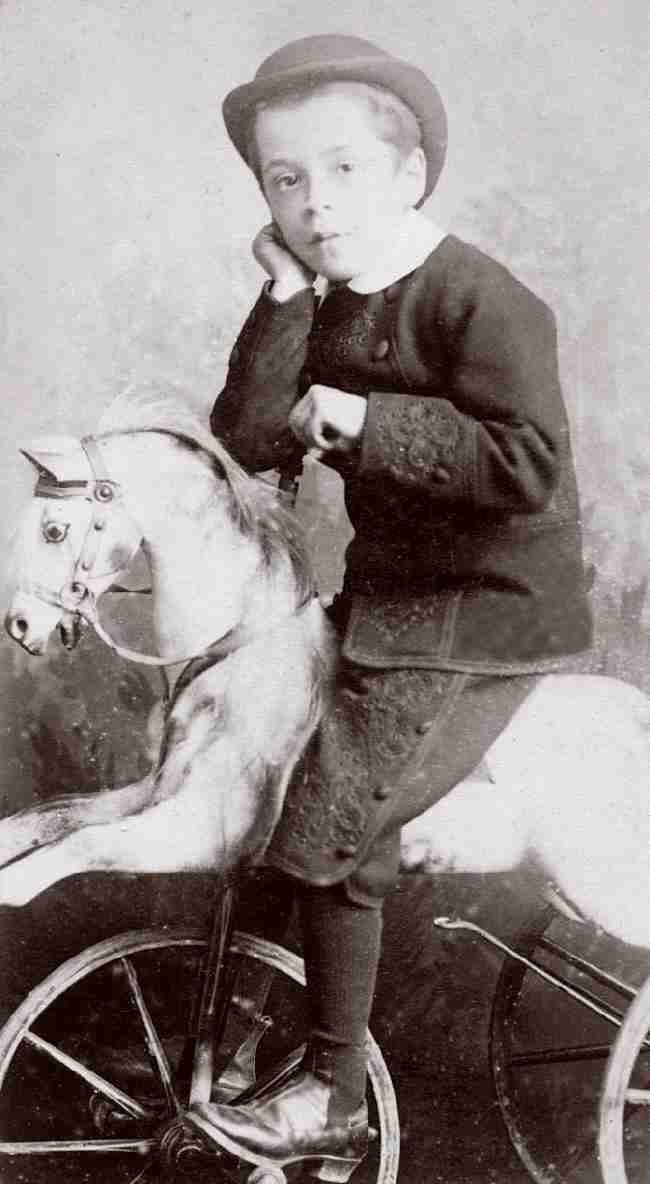
Hobby, Rocking, and Stick Horses: Boy Indicators

Figure 1.-- This CDV was taken at the Studio of A & G Taylor, London about 1880. The subject is unidentified. The bowler hat was unusual. Much more common were sailor hats and caps. Note the heavy embroidery on the jacket and kneepants. Image courtesy of the MD collection.
|
As a result of the association of boys and hobby horses, they are a useful indicator in interpreting gender in these images. We note quite a wide age range of boys on hobby horses of various descriptions. We also note boys wearing a wide variety of clothes. One of the most common outfits were sailor garments, but imges of boys on hobby horses jow tem dressed in virtually every conceivable garment. Many were not yet breached and work kilts, dresses, and other skirted garments. Some of the boys were quite young. Others seem older than you would expect to be still riding them. Perhaps they were old friends from early childhood or perhaps it was more accepted for older boys to divert themselves with hobby horses. We believe, for example, that a child in a dress siting astride a hobbyhorse or stuffed animal may likely be a boy. A good example here is a family portrit of the French De Lesseps family. We have, however, insufficent information at this time to say with authority that this is a strong indicator. Many of the available images are not identified. For those images that are identified, virtually all of the children in skirted garments riding astride are boys. We do not some boys in skirted garments posed side saddle, but we are not sure why.
Useful Indicators
As a result of the association of boys and hobby horses, the presence of a hobby horse in a portrait is a useful indicator in interpreting gender in unidentified images. The child's position may be especially important. Quite a variety of factors, however, are involved.
We note quite a wide age range of boys on hobby horses of various descriptions. Here there were both hobby horses that could be rode as well as some that were more like pull toys. Some of the boys were quite young. Many were not yet breached. Boys were often breached at about age 5-6 years old, there were, howevr, substantial variations from fmuly to family. Others seem older than you would expect to be still riding them. Perhaps they were old friends from early childhood or perhaps it was more accepted for older boys to divert themselves with hobby horses. Some boys seem as old as about 10 years, but most were much younger. The gender of the oldr boys is usually fairly obvious. Some of the younger children are much more difficukt to identify.
We also note boys on hobby horses wearing a wide variety of clothes. Unfortunately as most of these hobbyhorse portraits are studio portraits, they are not a good indicator of what boys wore in the nursery when riding their hobbyhorses. They are of course a good indicaror of the children's best outfits which mother selected for their portraits. One of the most common outfits we have noted for these portraits were sailor garments. This is a reflection of how popular the sailor suit was in the late 19th century. The portraits show many other outfits a well. Portraits of boys on hobby horses show them dressed in virtually every conceivable garment. Many were not yet breached and work kilts, dresses, and other skirted garments. This includes boys dressed in sailor kilts and dresses. Many of the boys can be identified even before breaching, but there are a few images that HBC is not sure about the gender.
Hair Styles
We believe, for example, that a child in a dress siting astride a hobbyhorse or stuffed animal may likely be a boy. A good example here is a family portrit of the French De Lesseps family. We have, however, insufficent information at this time to say with authority that this is a strong indicator. Many of the available images are not identified. For those images that are identified, virtually all of the children in skirted garments riding astride are boys. We do note some boys in skirted garments posed side saddle, but we are not sure precisely why. We think it was probably more likely a position simply to take a portrait. Most of the boys not yet breachd sit astride the hobby horses in the portraits we have noted. This is fairly ell established. We are less sure about how girls rode hobby horses, in part because we have relatively few portraits of grls on hobby horses.
HBC

Navigate the Boys' Historical Clothing Web Site:
[Return to the Main hobby horse gender indication page]
[Introduction]
[Activities]
[Biographies]
[Chronology]
[Clothing styles]
[Countries]
[Theatricals]
[Bibliographies]
[Contributions]
[FAQs]
[Glossaries]
[Satellite sites]
[Tools]
[Boys' Clothing Home]
Created: June 30, 2003
Last updated: July 2, 2003



